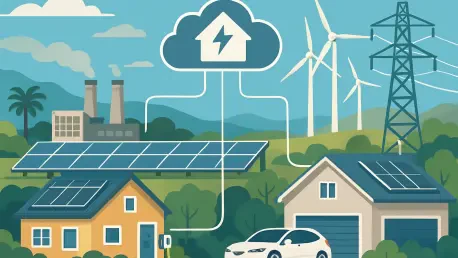What happens when a state renowned for pioneering clean energy pulls funding from a program hailed as the world’s largest virtual power plant? California’s grid, already under strain from scorching heatwaves and raging wildfires, faces a precarious moment as lawmakers have slashed support for a critical initiative designed to keep the lights on during crises. This decision, driven by a massive budget shortfall, has left energy experts and advocates reeling, questioning how the Golden State can balance fiscal woes with its bold climate ambitions. The story of this defunding unfolds as a stark reminder of the tightrope between innovation and economic reality.
A Critical Blow to Grid Innovation
At the heart of this controversy lies the Demand Side Grid Support (DSGS) program, a groundbreaking effort that aggregates distributed energy resources like rooftop solar, electric vehicle batteries, and smart thermostats to stabilize the grid during peak demand. Often dubbed the largest virtual power plant globally, DSGS boasted over one gigawatt of enrolled capacity, with 750 megawatts from batteries alone. A test event earlier this year proved its mettle, dispatching over 500 megawatts to the grid during a crucial two-hour window of stress, showcasing its potential to avert blackouts.
The significance of this program cannot be overstated. California, a leader in renewable energy adoption, has set aggressive targets to decarbonize its grid while grappling with climate-driven challenges that test infrastructure limits. Virtual power plants like DSGS offer a lifeline by reducing reliance on costly, polluting gas peaker plants, potentially saving ratepayers $206 million through 2027, according to a study by The Brattle Group. Losing this initiative threatens not just grid reliability but also the state’s clean energy trajectory.
Budget Battles Behind the Cut
The decision to defund DSGS, alongside the related Distributed Electricity Backup Assets (DEBA) program, stems from a staggering $12 billion budget shortfall facing California this year. Initially, nearly a billion dollars had been earmarked for these grid reliability efforts, with expectations of over $400 million through 2027 from the Greenhouse Gas Reduction Fund. Yet, during intense legislative negotiations, both programs were excluded from the final energy policy package, a move that stunned many in the energy sector.
This fiscal crunch forced tough choices, with lawmakers prioritizing immediate financial survival over long-term investments. The reauthorization of the state’s cap-and-trade system as “cap and invest” marked a legislative win for climate policy, but the omission of funding for DSGS and DEBA revealed a glaring gap. As a result, the future of these programs hangs in limbo, with operations potentially grinding to a halt by next year if alternative support isn’t secured.
Industry Outcry Over Lost Potential
Voices from the energy community have sounded alarms over the implications of this defunding. Kate Unger of the California Solar and Storage Association cautioned that DSGS could cease functioning entirely, leaving participants at risk of non-payment for their contributions by 2026. Such an outcome could erode trust in similar initiatives, hampering future efforts to build a resilient grid through distributed resources.
Edson Perez of Advanced Energy United labeled the decision a “huge missed opportunity,” criticizing the opaque nature of legislative trade-offs where these programs were sidelined in what he called a “black box” of negotiations. Backed by data from The Brattle Group’s study, which highlighted significant cost savings, these concerns underscore a broader frustration: California may be forfeiting a proven solution at a time when grid stability is more critical than ever.
Ripple Effects on Energy Costs and Climate Goals
Beyond operational setbacks, the economic consequences of defunding DSGS are substantial. The program’s ability to dispatch power during emergencies reduces the need for expensive backup systems, directly benefiting ratepayers. Without it, reliance on gas peaker plants could drive up electricity costs, countering efforts to make energy more affordable for Californians already burdened by high living expenses.
Moreover, this move jeopardizes the state’s environmental commitments. Virtual power plants play a key role in integrating renewables into the grid, cutting greenhouse gas emissions by curbing fossil fuel use during peak times. With climate challenges intensifying—evident in record-breaking heat and wildfire seasons—abandoning such initiatives risks slowing progress toward decarbonization, even as other parts of the recent energy package aim to advance clean power goals.
Charting a Path Forward Amid Uncertainty
Despite this setback, pathways exist to salvage California’s grid reliability efforts. Advocates like Perez remain cautiously optimistic about securing alternative funding sources early next year, potentially through redirected portions of the “cap and invest” program or federal grants focused on grid resilience. Such measures could breathe new life into DSGS and DEBA, preserving their contributions to energy stability.
Public awareness also holds power to shift the tide. Highlighting tangible benefits, such as fewer blackouts during extreme weather or the projected $206 million in savings, could rally ratepayer support and pressure lawmakers to prioritize reinvestment. Additionally, the recent energy package’s codification of virtual power plants in long-term planning offers a framework for future action, provided policymakers commit to concrete timelines and financial backing.
Looking back, the defunding of California’s largest virtual power plant stood as a defining moment of tension between fiscal necessity and energy innovation. As the state wrestled with immediate budget constraints, the loss of DSGS and DEBA underscored the fragility of progress in the face of economic hardship. Yet, the resolve of advocates and the promise of alternative funding hinted at redemption. Moving forward, stakeholders needed to push for creative financial solutions, amplify public advocacy, and ensure that virtual power plants remained central to grid planning. Only through such concerted efforts could California reclaim its footing as a beacon of clean energy, proving that even in tough times, sustainability and reliability could coexist.









